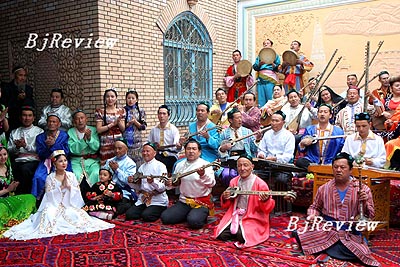|
Nowadays, there are fewer than 1,000 well-trained Guqin players and perhaps no more than 50 surviving masters. The original repertoire of several thousand compositions has drastically dwindled to a mere hundred works that are regularly performed today.
The Art of Uygur Muqam of Xinjiang-Mother of Uygur Music
Proclamation date: November 25, 2005
Brief Introduction:
The Xinjiang Uygur Muqam is the general term for a variety of Muqam practices widespread among the Uygur communities, which form one of the largest ethnic minorities of China. Throughout history, the Xinjiang region has been marked by a high degree of cultural exchange between East and West, in particular due to its location on the hub of the Silk Road.
As the most prestigious and well-known genre of Uygur music, Muqam is a composite of songs, dances, folk and classical music, and characterized by diversity of content, dance styles, musical morphology and instruments used.
The songs vary in rhyme and meter and are performed solo as well as in groups. The lyrics contain not only folk ballads but also poems written by classical Uygur masters. Thus, the songs reflect a wide range of styles such as poetry, proverbs, folk narrative and popular topics such as the praise of love and contemplation on life, reflecting the history and contemporary life of the Uygur society.

The dancing skills involve unique steps, rhythms and formations as well as figures such as flower-picking-by-mouth, bowl-carrying-on-head and imitation of animals in solo dances.
In Muqam ensembles, the lead instruments, called Satar or Aijak, are made from local materials and vary in form (they may be bowed-stringed, plucked or wind instruments). The Xinjiang Uygur Muqam has developed four main regional styles, namely the 12 Muqam, Dolan Muqam, Turpan Muqam and Hami Muqam.
Today, traditional community festivities, in which everybody participates in the Muqam, are held much less frequently. The responsibility for passing on the tradition to new generations of practitioners has fallen on the shoulders of folk artists, and the interest of young people in Muqam is gradually declining. Now, several Muqam pieces are no longer performed, in particular certain elements of the “12 Muqam”, which consists of more than 300 pieces of a total length of over 20 hours.
Traditional Folk Long Song--Living Fossil of Mongolian Music
Proclamation date: November 25, 2005
Brief Introduction:
The Long Song is one of two major forms of Mongolian songs (the other is Short Song). Reflecting nomadic culture of Mongolians, Long Song is closely associated with the Mongolian language, literature, history, religion, life, customs and conventions and plays a distinct and honored role within Mongolian society.
It is performed at weddings, the inauguration of a new home, the birth of a child, the branding of foals or other social and religious festivities celebrated by Mongolia’s nomadic communities. Long Song can also be heard at the naadam, a festivity celebrating sports competitions in wrestling, archery and horseracing.
Long Song is a lyrical chant made of 32 verses with a highly ornamented melody praising the beauty of the steppe, mountains and rivers, the love for parents or close friends, expressing reflections on human destiny. It is characterized by an abundance of ornamentation, falsetto, a long and continuously flowing melody with rich rhythmical variation, an extremely wide vocal range and a free compositional form. The rising melody is slow and steady while the falling melody is often intercepted with a lively triple continuant, imitating the pace of life on the grasslands.
Long Song is seen as expressions of Mongolians to nature and the vast grassland and is acclaimed by artists as a perfect unification between men and nature, heart and sky.
The art is believed to date back 2,000 years and have been recorded in literary works since the 13th century. A rich variety of regional styles has been preserved until today, and performances as well as contemporary compositions still play a major role in the social and cultural life of nomads living in Mongolia and in the Inner Mongolia Autonomous Region in China.
Since the 1950s, urbanization and industrialization have increasingly superseded traditional nomadic lifestyles, leading to the loss of many traditional customs and expressions. The repertoire of Long Song is gradually diminishing. In addition, the unique singing form of Mongolians is facing the danger of dying out as most Long Song folk singers are getting older and some even have passed away.
|
UNESCO has four major programs in the field of intangible cultural heritage:
- Proclamation of Masterpieces of the Oral and Intangible Heritage of Humanity
- Living Human Treasures
- Endangered Languages
- Traditional Music of the World |
(Compiled by ZAN JIFANG) | 